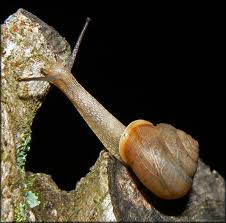Nutrition
Daedalochila subclausa feed primarily on the mycelia of fungi (Pilsbry, 1940).
In order to eat, the snail uses its radula, a rasping organ that can scrape food and act like a conveyor belt by carrying the food inside the mouth. The radula contains thousands of teeth made of chitin to aid in eating (Hickman, 2009).
Newly acquired food passes through a complete digestive tract consisting of a stomach, digestive gland, and intestine. Enzymes produced in the digestive gland break the food down for absorbtion. After the nutrients get absorbed, the leftover metabolic wastes, as well as excess water are removed from the coelomic fluid by a pair of nephridia. These nephridia are similar to kidneys but work in a different manner as they filter coelomic fluid instead of blood (Hickman, 2009). Waste is collected in the snail body and exits through the anal pore.
Daedalochila subclausa has an open circulatory system which pumps ‘blood’ or hemolymph into a series of cavities and sinuses to exchange gases for respiration. This is possible because the snail's mantle is modified to serve as a lung. Air enters an opening in the mantle called a pneumostome (Hickman, 2009). The heart is contained within a cavity called the pericardium and pumps blood to internal organs. Snails like Daedalochila subclausa move extremely slow because they have an open circulatory system. This makes it difficult for blood to move quickly for fast gas exchange which in turn limits the snails speed (Snail Anatomy).
To see how Daedalochila subclausa interacts with other species, click on Interactions.